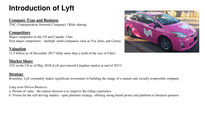Company Type and Business
TNC (Transportation Network Company) / Ride-sharing
Competitors
Major competitor in the US and Canada- Uber
Non-major competitors - multiple small companies such as Via, Juno, and Carma
Valuation
11.5 billion as of December 2017 (little more than a tenth of the size of Uber)
Market Share
35% in the US as of May 2018 (Lyft just entered Canadian market at end of 2017)
Strategy
Branding: Lyft constantly makes significant investment in building the image of a mature and socially responsible company
Long-term Driven Business:
a. Pursuit of value - the utmost mission is to improve the riding experience
b. Vision for the self-driving market - open platform strategy, offering strong brand power and platform to business partners
Market Landscape
Low barrier to entry - it’s not particularly difficult to enter the ride-sharing market, so the potential for competition is abundant.
Uber is currently the industry leader with 65% market share in the US, with additional markets in Canada, Asia and Europe.
Lyft is the #2 in US market share with no market in Asia or Europe. It is one of the most well established brands in the sector.
The market opportunity is abundant for Lyft now, due to several issues faced by Uber:
Uber was sued for 433 times in 2017, including lawsuit for drivers’ sexuall assault or harassment towards passngers.
Uber’s CEO was accused of withholding information during negotiations with an investor for board seats. The withheld information related to allegations of sexual assaults by Uber executives and junior level staff. The investors alleged that they would have never granted the board seats to Lyft if they were aware of the allegations.
Uber and Lyft
Both Companies:
Operate in the US and Canada (Lyft entered Canada in 2017 as its first international market expansion)
Have an affiliation with a major food partner, allowing them entry into the food delivery business (Lyft is rolling out “Taco Mode”, which allows users to direct drivers to the closest Taco Bell)
Have similar pricing structures, charging elevated fees known as surge pricing during certain times of the day.
Offer multiple types of vehicles and ride “types”, including rides in large SUVs, sedans for 4-6 people, luxury automobiles, and ride sharing options (multiple passengers with different destinations) to reduce costs.
How does Lyft differentiate itself from Uber?
Tipping: One of the primary benefits of Lyft’s business model is Lyft allows for tipping on its platform. This idea creates incentive for the drivers to provide for the best rides possible for the passenger. The mutually beneficial arrangement creates an experience that’s financially rewarding for the drivers and comfortable and expedient for the passengers.
Culture: When Lyft was first rolled out, its vehicles were characterized by a big pink mustache on the grille of the car. Lyft has since adopted an “amp” in 2016 which shines a particular color and is paired with the color shown on a passenger application, which helps riders figure out what vehicle to look for during pick-up.
Opportunity: Lyft has yet to expand in the European or Asian markets. All of the market share generated thus far has been from US and Canadian business. With all of the issues faced by Uber, it could be a prime opportunity for Lyft to seize the market in Europe and Asia.
1. The Lyft guys reveal their kinder gentle plan to crush uber
https://www.vanityfair.com/news/2017/09/lyft-co-founders-interview
2. Lyft claims it now has more than one-third of the US ride-sharing market https://www.cnbc.com/2018/05/14/lyft-market-share-051418-bosa-sf.html
3. Lyft wants to be the Android of autonomous vehicles
https://arstechnica.com/cars/2017/09/lyfts-ambitious-plans-to-win-the-self-driving-wars/
4. Six Genius Things Lyft Is Doing While Everyones Hating on Uber
https://www.inc.com/erik-sherman/6-genius-things-lyft-is-doing-while-everyones-hatingon-Uber.html
5. Lyft enters Canada in first international market
http://www.businessinsider.com/lyft-enters-canada-in-first-international-market-2017-11
6. Lyfts Second-Mover Advantage Pays Off in Canadian Expansion
https://www.bloomberg.com/news/articles/2018-05-08/lyft-s-second-mover-advantage-pays-off-in-canadian-expansion
The thinking behind the bright colors and the pink mustache is because it was whimsical and irreverent. This idea supports the “fun” image Lyft is trying to cultivate. It’s starkly contrasted with Uber, who uses black, white and gray for its branding.
The three-way sentimental analysis includes Lyft ->Driver, Driver->Passenger and Passenger -> Driver. The purpose of the analysis is to gauge the sentiments each connection has of the other.
Social - Round up programs include partnership with Blue cross blue shield which provides transportation to hospitals












 분야
분야


